2.93GHz with DDR2-1067 Performance Comparison
It is clear enough that despite the poorer memory bandwidth, Core 2 Duo is the performance leader by a substantial margin at stock speeds. You have seen that in all of the results posted in this article. This conclusion will not satisfy all our readers, however. Many have theorized every incarnation of performance imaginable with AM2 having higher clock speed, higher bandwidth, or higher speed memory than it currently does.
To best answer these questions we put together the fairest comparison we could think of to directly compare Core 2 Duo and AMD AM2. This consists of running both processors at the exact same speed - 2.93GHz - achieved at the same ratios - 11x266. This involves overclocking the AM2 FX62 to 2.93GHz and raising the "bus" speed to 266. That allows an 11x266 ratio to match Core 2 Duo. The desirable side effect is that while AM2 does not really support DDR2-1067, by setting the memory to DDR2-800 we reach DDR2-1067 speed at the 266 speed setting. While this slightly stacks the deck in AMD's favor, it is as close as it is possible to get at running the two systems at the same speed, same memory timings, same memory voltages, same memory, and same video card. We are comparing two identically configured systems with AM2 powering one system and Core 2 Duo powering the other system.
Results are particularly interesting in that the fastest current AM2 processor, the FX62, is overclocked about 5% in CPU speed and 33% in "bus" speed over a stock AM2 system.
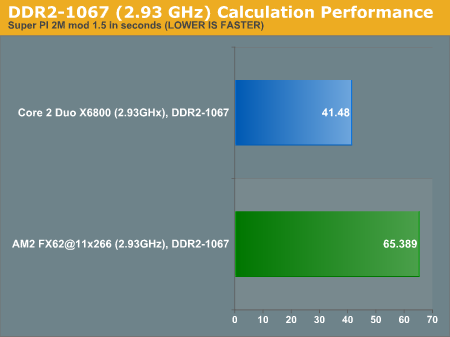
Frankly the gap that remains in Super Pi results when comparing AM2 and Core 2 Duo at the same speed was something of a shock. Clock for clock, with all other variables the same, Core 2 Duo is still almost 60% faster than AM2. There is nothing complex about calculating the value of Pi to 2 million places, but it does show the true power of Conroe in computation-intensive tasks.
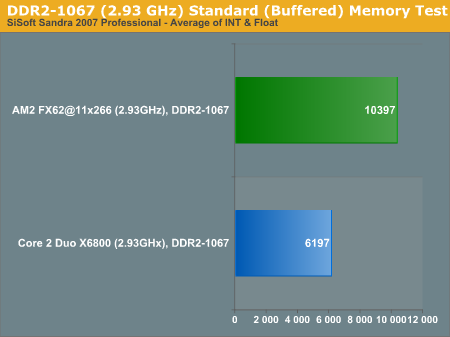
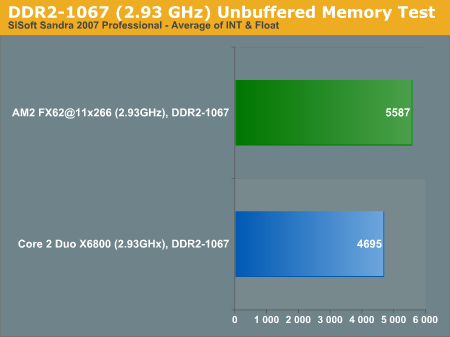
Despite the improvements Intel has made in intelligent read-ahead for memory, AM2 still has a huge lead in buffered memory bandwidth. This is a result of the superior on-processor memory controller used on AM2. The results become much closer in Unbuffered memory results, which is normally more revealing of performance in real-world applications, but AM2 still has a wider memory bandwidth. The unfortunate reality is AM2 is not starved for memory bandwidth and cannot really make effective use of this advantage. AMD clearly knows how to deliver memory bandwidth, so the task now becomes to modify their core logic to make better use of this advantage.
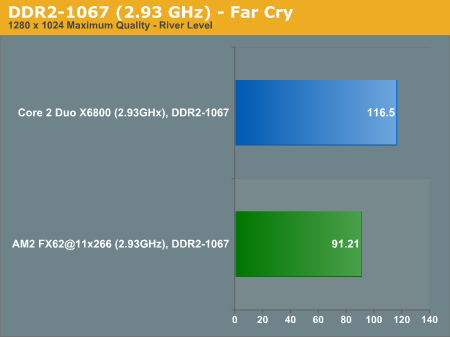
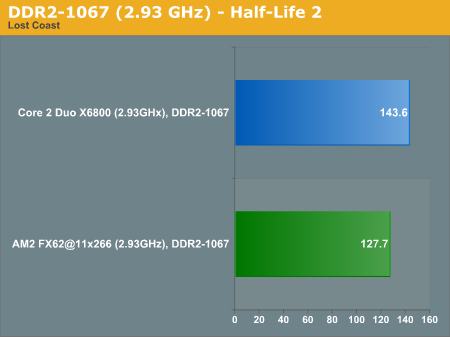
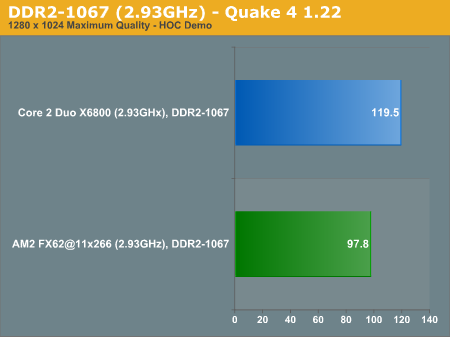
We can now say with authority that Core 2 Duo is the faster performer clock-for-clock across the board. At the same 2.93GHz Far Cry is 27.7% faster, Half-Life 2: Lost Coast is 12.4% faster, and Quake 4 is 22.2% faster on Core 2 Duo. Of course AMD does not currently have a 2.93GHz CPU, so we tested by overclocking FX62. This suggests that FX64, or whatever it will be called, will not help much at 3.0GHz with a 200 clock speed.
It is clear enough that despite the poorer memory bandwidth, Core 2 Duo is the performance leader by a substantial margin at stock speeds. You have seen that in all of the results posted in this article. This conclusion will not satisfy all our readers, however. Many have theorized every incarnation of performance imaginable with AM2 having higher clock speed, higher bandwidth, or higher speed memory than it currently does.
To best answer these questions we put together the fairest comparison we could think of to directly compare Core 2 Duo and AMD AM2. This consists of running both processors at the exact same speed - 2.93GHz - achieved at the same ratios - 11x266. This involves overclocking the AM2 FX62 to 2.93GHz and raising the "bus" speed to 266. That allows an 11x266 ratio to match Core 2 Duo. The desirable side effect is that while AM2 does not really support DDR2-1067, by setting the memory to DDR2-800 we reach DDR2-1067 speed at the 266 speed setting. While this slightly stacks the deck in AMD's favor, it is as close as it is possible to get at running the two systems at the same speed, same memory timings, same memory voltages, same memory, and same video card. We are comparing two identically configured systems with AM2 powering one system and Core 2 Duo powering the other system.
Results are particularly interesting in that the fastest current AM2 processor, the FX62, is overclocked about 5% in CPU speed and 33% in "bus" speed over a stock AM2 system.

Frankly the gap that remains in Super Pi results when comparing AM2 and Core 2 Duo at the same speed was something of a shock. Clock for clock, with all other variables the same, Core 2 Duo is still almost 60% faster than AM2. There is nothing complex about calculating the value of Pi to 2 million places, but it does show the true power of Conroe in computation-intensive tasks.


Despite the improvements Intel has made in intelligent read-ahead for memory, AM2 still has a huge lead in buffered memory bandwidth. This is a result of the superior on-processor memory controller used on AM2. The results become much closer in Unbuffered memory results, which is normally more revealing of performance in real-world applications, but AM2 still has a wider memory bandwidth. The unfortunate reality is AM2 is not starved for memory bandwidth and cannot really make effective use of this advantage. AMD clearly knows how to deliver memory bandwidth, so the task now becomes to modify their core logic to make better use of this advantage.



We can now say with authority that Core 2 Duo is the faster performer clock-for-clock across the board. At the same 2.93GHz Far Cry is 27.7% faster, Half-Life 2: Lost Coast is 12.4% faster, and Quake 4 is 22.2% faster on Core 2 Duo. Of course AMD does not currently have a 2.93GHz CPU, so we tested by overclocking FX62. This suggests that FX64, or whatever it will be called, will not help much at 3.0GHz with a 200 clock speed.










118 Comments
View All Comments
duploxxx - Thursday, July 27, 2006 - link
please give us edit...powerconsumption is only less in 100% load.... when powermode kicks in the amd is much less consuming... how long do you think a system runs in powermode against full load....
duploxxx - Thursday, July 27, 2006 - link
wrong... the conroe gains from the memory speed the amd more thats a fact... the ones you are referring to are probably 4200 and 5000, well we can say that they perfrom better when using 533/667 because then they don't have the devider issue running the memory on 742 in stead of 800.so the performance/price ratio on those chips is better with 553/667
zsdersw - Thursday, July 27, 2006 - link
Conroe's performance isn't merely a function of memory bandwidth or memory speed.PeterR - Tuesday, July 25, 2006 - link
If you could actually go out and BUY one ?Peter R.
michal1980 - Tuesday, July 25, 2006 - link
Wow. AMD fanboi's pulling out all the crap that the intel fanboi's have pulled in the past.wake up!. Right now, Intel core 2 duo is faster then AMD 64 right now.
Its like video card fanboi's but worse, because the difference here is clear.
If I was building a gaming rig this year, I would build with a core 2 duo.
Just like a few months ago, it would be with an AMD 64.
I go with what company is faster. I used both nvidia cards, and ati Cards. I use pentiums, and p2's, I used athlon xp's when you over clock them 50% ease and they were dirt cheap. I use a opty dual core right now because it was faster then the p4's. I use p-m lappys because of performance/battery life.
If I was building a rig right now. I'd switch to an intel Core 2 duo. Why? because its faster. I could care less about who makes it.
if apple comes out tommorow with a magic pc that runs all pc games run 20% faster, I'm buying an apple.
Pirks - Tuesday, July 25, 2006 - link
I'd buy a iMac or Mac Pro right this second if it were running all PC games at all without rebooting between OS X and XP.yacoub - Tuesday, July 25, 2006 - link
Two things:1 - I think I like the new font used in tables and charts.
2 - In the SuperPi chart you say Lower is Better but then inverse the graph such that it is actually the line higher on the graph that is better. Unless the reader looks closely at the numbers, they could infer that the AMD chip wipes the floor with the Conroe.
redbone75 - Tuesday, July 25, 2006 - link
Seriously, though, here we have a completely new architecture from Intel, the same Intel that is this massive company with enormous resources and huge R&D departments, and these AMD fanboys are still all upset because Intel has not only achieved parity with but also exceded AMD in performance. Come to think of it, this is the exact same argument that AMD fans were using when preliminary benchmarks came out on Conroe. "It's not fair to compare Intel's new architecture to AMD's old one, because they have an advantage." Hey, you want some cheese with that wine? I'll tell you what: AMD enjoyed the performance lead for a while. Now, Intel is having a go at it and, with any luck, AMD will come out on top in the future, at least I really hope so. Why do I hope so? Do any of you think AMD would have lowered their processor prices so much if Conroe wasn't such a threat? Do you think Intel would have released Conroe at these prices if they didn't have to take back the crown from AMD? Hey, with the X2's we still get a great range of processors at much lower prices. Hell, even the Pentium D's are going to be attractive at lower prices. That makes me happy, not some benchmarks saying this processor is faster than that processor. And really, I don't know about you but I don't care about which processor wins memory latency benches, I only care about the end performance in applications I actually use.DigitalFreak - Tuesday, July 25, 2006 - link
Amen, brother!TravelMug - Tuesday, July 25, 2006 - link
As said by several people before - you are not testing latency but the prefetch abilites of the CPU. Same has been said about the original Conroe article, you don`t seem to listen though."Everest from Lavalys shows latency improvements in the new CPU revisions, but it shows Latency more as we would expect in evaluating Conroe. For that reason, our detailed benchmarks for latency will use both Everest 1.51.195, which fully supports the Core 2 Duo processor, and ScienceMark 2.0."
Really? That is a 2 years old version, there have been countless new version since then. Also, if that version "fully supports" the Core 2 Duo processor, how come this is what the developer says about the latest version 3.01?:
http://www.lavalys.com/products/whatsnew.php?pid=3...">Support for Intel Core 2 "Conroe" and "Merom" processors